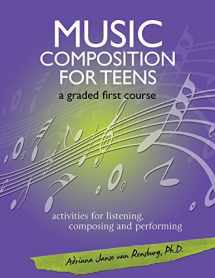
Music Composition for Teens: a graded first course
Book details
Summary
Description
This book contains explorative activities in listening, composing and performing for the creative teacher who wishes to either introduce or expand composition in the music class. It is a graded course ranging from the simplest of rhythmic and pitch activities to more advanced work on triads, four-part writing and 20th century techniques. Each chapter contains extended lesson ideas that provide background, explorative ideas to inspire and inform the young composer, and directions for composing. Exploration engages the imagination and inspires critical thinking, speculation, and the creative process. This is also a multimedia course that uses keyboards, instruments, video, recording devices, computers, notation software and other media. It is aimed at encouraging student interactivity with various media. It is also a multi-arts course as visual, dramatic and language arts are included where applicable. The course includes music from various cultures and this multi-cultural approach allows students to develop a deeper understanding of various tone systems, instruments and musical approaches used across the world. Assignments focus on structured creativity which guides students to symbolize sound through guided composition activities, thus enabling students to acquire a musical literacy. This composition course is neither a theory nor a harmony method, but rather a composition skill and knowledge builder. Teachers may supplement composition assignments with more detailed theory and harmony if necessary. This course is aimed at the acquisition of standard notation skills. In addition there is an introduction to the use of improvisation, electronic media and twentieth-century techniques employing graphic notation. The first composition assignments begin with simple four measure phrases. The assignments become more challenging as the course progresses. Compositions need not be enormous works of many pages. Indeed, shorter compositions which accurately demonstrate a compositional device will be far more worthwhile and less daunting to the beginner composer. Any of the composition assignments can be expanded if necessary. Even the simplest four measure structure can be expanded to a lengthy composition by using the devices learned in the module. Teachers should engage students through and anticipatory explorative set at the start of composition activities with suitable listening, visual, kinesthetic and explorative activities. Exploration engages the imagination and inspires critical thinking, speculation and the creative process. Suggestions have been included where applicable. Listening suggestions include more well-know works easily accessible in the media. A wide variety of musical styles is addressed and explored in this course. Teachers should use discretion, not all assignments would be suitable for your particular group. However, by exploring many musical styles e.g. jazz, African music, modes, Boogies, etc. the idea remains that Composing and creative activities are for skill building and application; Knowledge regarding various musical styles and cultures should be gained through active, creative exploration; Various styles and compositional techniques should be learned, not to stereotype student compositions, but to broaden the young musician’s scope and horizons. Photocopiable material is included.


We would LOVE it if you could help us and other readers by reviewing the book
Book review



